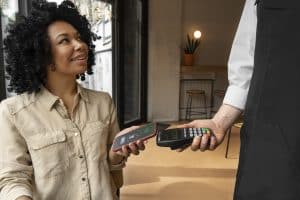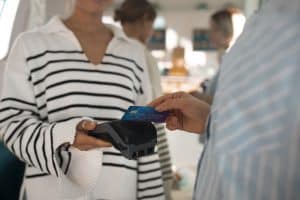Contactless payment adoption 2025: A new era of payments


Contactless payment adoption is transforming how we buy, sell, and interact with money in 2025.
As the demand for faster, touch-free transactions grows, more businesses are turning to this technology to enhance efficiency and meet consumer expectations.
With just a tap of a smartphone or card, payments are completed in seconds — no need for cash, swipes, or signatures.
This shift is more than a trend; it’s a new standard in modern commerce that’s reshaping the customer experience across industries.
Curious about how contactless payment adoption is redefining everyday purchases? Let’s dive into what makes this innovation so powerful — and why it’s here to stay.
Understanding Contactless Payment Technology in 2025
To fully grasp the rise of contactless payment adoption, it’s essential to understand how the technology behind it works and why it’s gaining global traction.
At its core, this innovation allows users to complete payments by simply tapping a smartphone, smartwatch, or contactless card on a compatible terminal — no PINs, no swiping, no physical contact.
The rapid growth of contactless payment adoption is powered by advancements in wireless communication and consumer demand for safer, faster transactions.
This technology is revolutionizing everyday purchases and setting a new standard for convenience.
How Contactless Payment Technology Works
Contactless payment adoption relies on Near Field Communication (NFC), a secure, short-range communication method that enables data exchange between a payment device and terminal.
Here’s how a typical contactless payment transaction happens:
- The device emits a secure, short-range NFC signal.
When held near a compatible terminal, your smartphone or card sends encrypted transaction data. - The terminal reads the signal and verifies the data.
Within milliseconds, the system confirms identity and payment details. - The transaction is processed and completed instantly.
No need to touch the machine, insert a card, or enter a PIN (for most purchases).
This entire process usually takes less than a second, making it one of the fastest ways to pay — and a key reason why contactless payment adoption is becoming the preferred method in retail, transportation, dining, and beyond.
Speed and Simplicity Redefined
One of the biggest drivers of contactless payment adoption is the unmatched speed and ease it offers. Long checkout lines are replaced with quick taps, and complex steps are removed from the buying process.
This creates a more seamless customer experience — especially valuable during peak hours or high-traffic situations.
Enhanced Safety and Hygiene
Health and safety have become top priorities for consumers. Contactless payment technology eliminates the need for shared surfaces, reducing the spread of germs and making everyday transactions safer.
This feature became especially critical during the pandemic and continues to be a lasting motivator for adoption.
Biometric Authentication Adds Security
In many mobile wallets, transactions via contactless payment are further secured through biometric verification — like fingerprints or facial recognition.
This means that even if a phone is lost or stolen, unauthorized use is far less likely. Combined with tokenization and data encryption, it creates a multilayered security framework trusted by millions.
Why Businesses Are Investing in Contactless Solutions
Beyond consumer convenience, contactless payment adoption brings measurable benefits to businesses:
- Faster service times, allowing for more transactions per hour
- Reduced cash handling, which minimizes errors and theft
- Improved customer satisfaction, leading to higher loyalty and return visits
As more people embrace this payment method, companies that offer contactless options are positioning themselves at the forefront of digital transformation in retail.
Key Benefits of Contactless Payment Adoption for Consumers and Businesses
The growing contactless payment adoption trend is more than a shift in technology — it’s a transformation in how we experience everyday purchases.
Whether you’re a consumer looking for speed or a business aiming to improve customer satisfaction, the advantages are both immediate and long-term.
More than just a modern convenience, contactless payment adoption is helping to redefine retail, hospitality, and service industries by making payments faster, safer, and more efficient.
Speed Enhances Customer Experience
One of the most widely recognized benefits of contactless payment adoption is speed. With just a tap, transactions are processed in seconds — no need to swipe cards, count change, or enter PINs.
This reduction in checkout time:
- Shortens waiting lines, especially during peak hours
- Boosts operational efficiency, allowing staff to serve more customers
- Creates a frictionless purchase experience that keeps people coming back
Faster checkouts mean happier customers — and for businesses, that often translates into increased revenue.
Convenience That Encourages Spending
Contactless payments are incredibly easy to use, making them ideal for spontaneous purchases and busy lifestyles. Customers can leave their wallets at home and simply use their phone, smartwatch, or card to complete a transaction.
No More Searching for Cash or Cards
Users don’t need to fumble at the register or worry about carrying exact change.
Lightweight Wallets and Mobile Integration
With everything stored digitally, consumers carry fewer physical items and enjoy seamless integration with apps like Apple Pay, Google Pay, or Samsung Wallet.
Encourages Quick and Frequent Purchases
Convenience leads to increased spending, especially in sectors like food, retail, and public transport where speed matters most.
Health and Hygiene Remain a Priority
Since the COVID-19 pandemic, contactless payment adoption has also been viewed through the lens of public health. Reducing contact with payment terminals or handling cash decreases the risk of germ transmission.
- Minimized surface contact helps prevent the spread of viruses
- Safer payment distances allow customers and staff to maintain hygiene protocols
- Trusted by health-conscious consumers, especially in healthcare and food sectors
This health benefit continues to influence consumer behavior, solidifying contactless payments as the preferred method in many industries.
Strong Security Features Offer Peace of Mind
While some users worry about digital payments, contactless payment technology is built with advanced security measures that protect data and prevent fraud.
Encryption Secures Data in Transit
All communication between the device and terminal is scrambled, making it unreadable to outsiders.
Tokenization Replaces Sensitive Information
Instead of transmitting actual card details, a unique digital token is used to authorize the transaction — minimizing the risk of data theft.
Built-in Consumer Protections
Most banks and credit card issuers offer limited liability, protecting users against unauthorized or fraudulent charges.
Together, these features make contactless payment adoption not only convenient but also highly secure for both users and businesses.
Ideal for Businesses of All Sizes
Contactless payment adoption isn’t limited to big retail chains. Small and medium businesses are quickly catching up, recognizing the value it brings in attracting modern consumers.
-
Greater customer reach by catering to digital-first shoppers
-
Competitive edge over businesses that only accept traditional payment methods
-
Streamlined operations, reducing manual cash handling and human error
As we move toward a cashless economy, businesses that adopt contactless options are better positioned to grow and adapt to shifting consumer expectations.
Key Challenges in Contactless Payment Adoption for 2025

Despite its rapid expansion and numerous advantages, contactless payment adoption still faces a variety of obstacles that can slow or complicate its implementation.
From technological limitations to consumer hesitation, businesses must be prepared to address these challenges to successfully adopt this payment method.
Understanding these barriers is essential for developing effective strategies, especially as customer expectations continue to evolve in a digital-first economy.
Technology Compatibility Is Not Always Guaranteed
One of the primary barriers to contactless payment adoption is the lack of compatibility with older systems.
Many businesses, especially small or independent merchants, still operate with outdated point-of-sale (POS) hardware that does not support NFC technology.
Upgrading Requires Investment
Merchants must often replace or retrofit existing terminals, which can be costly and time-consuming.
Integration with Current Systems May Be Complex
Contactless systems must integrate smoothly with inventory management, customer data tools, and accounting software. This can demand additional technical support and planning.
For businesses with limited IT resources, these upgrades can feel overwhelming — even if the long-term benefits are promising.
Consumer Awareness and Education Remain Low in Some Segments
For contactless payment adoption to be truly successful, both businesses and consumers must understand how it works and why it matters. However, awareness isn’t universal.
Security Concerns Create Hesitation
Some users still doubt the safety of tapping their phone or card, fearing their data could be intercepted or misused.
Lack of Knowledge Delays Usage
Many consumers simply don’t know how to use contactless payments — or that their cards and smartphones already support the technology.
Resistance to Change Slows Adoption
Traditional habits die hard. Some shoppers prefer cash or chip-and-PIN methods, especially older generations or individuals less comfortable with digital tech.
Educational efforts — both in-store and through digital marketing — are crucial to boost trust and familiarity.
Regulatory and Regional Differences Add Complexity
The rules around payment processing vary by country and even by region, adding another layer of complexity to contactless payment adoption.
- Compliance with financial regulations may require legal consultations and software adjustments.
- Data protection laws, such as GDPR in Europe, can impact how customer data is handled and stored.
- Payment limits for contactless transactions may differ by location, affecting consistency of use.
Businesses expanding internationally or operating in regulated industries must navigate these legal frameworks carefully.
Implementation Costs Can Be a Barrier for Smaller Merchants
Cost remains one of the most significant hurdles in contactless payment adoption, particularly for small businesses operating on thin margins.
Initial Setup Costs
Upgrading hardware, training staff, and configuring systems demand an upfront financial commitment that some may find intimidating.
Transaction Fees Accumulate Over Time
Although typically small per transaction, processing fees add up — especially in high-volume businesses. This can affect profitability if not carefully managed.
Training Staff Requires Time and Resources
Employees need to be familiar with the new system, able to assist customers, and troubleshoot basic issues. This can slow down operations temporarily and require dedicated training sessions.
No Guaranteed Immediate Return on Investment
While contactless payment adoption offers long-term benefits, businesses may not see an instant boost in revenue. Adoption rates depend on:
- Customer demographics and behavior
- Marketing effectiveness
- Regional payment culture
This uncertainty can make some merchants hesitant to invest, especially if their current systems are still functional.
The Future of Retail in a World of Contactless Payment Adoption

As contactless payment adoption continues to accelerate, the retail landscape is undergoing a fundamental transformation.
No longer just a trend, this technology is becoming the foundation of how customers shop, pay, and interact with brands — both online and in-store.
Retailers that embrace contactless solutions are creating faster, safer, and more personalized shopping experiences.
The shift is not only improving customer satisfaction but also redefining operational models, store designs, and marketing strategies.
Emerging Trends in Contactless Retail Experiences
The rise of contactless payment adoption is being driven by evolving consumer behavior and rapid tech advancements. Retailers are responding by embracing innovations that offer flexibility and speed.
Mobile Wallets Are Becoming the Norm
Apps like Apple Pay, Google Pay, and Samsung Wallet are seeing explosive growth, allowing customers to pay using their phones without carrying cards or cash.
Integration with Loyalty Programs
Many retailers are linking payment platforms to reward systems, providing instant discounts, points, or exclusive perks when customers tap to pay.
Wearables Are Expanding Payment Options
Smartwatches and fitness bands now offer tap-to-pay functionality, giving consumers even more ways to complete transactions without reaching for their wallets.
These trends reflect a broader shift: consumers want seamless, integrated payment options that fit into their digital lifestyles.
Rethinking the Retail Store Layout
Contactless payment adoption is also influencing the physical design of retail spaces. With fewer customers relying on traditional registers, stores are freeing up space and focusing on creating more open, interactive, and comfortable environments.
- Smaller checkout areas allow for more product displays or customer lounges.
- Self-service stations and kiosks improve flow and reduce wait times.
- Frictionless checkouts create a modern, tech-savvy image that attracts younger shoppers.
Retailers that prioritize convenience and ease of movement are more likely to retain foot traffic — even as online shopping continues to grow.
What Contactless Means for Modern Consumers
For shoppers, the continued growth of contactless payment adoption means greater convenience, improved safety, and enhanced peace of mind.
Tap-and-Go Saves Time
Transactions are completed in seconds, reducing queues and speeding up the entire shopping journey.
Safer, Cleaner Transactions
Especially post-pandemic, minimizing physical contact during payments has become a top priority for consumers seeking hygienic solutions.
Universal Acceptance Expands Options
With more businesses offering contactless options, consumers have fewer limitations on where and how they pay — whether it’s a high-end department store or a local market stall.
The convenience and trust that contactless payments offer are setting new expectations across the board.
A Glimpse Into the Next Phase
Looking ahead, the impact of contactless payment adoption in retail will likely deepen. We can expect:
- Biometric integrations, where facial or fingerprint scans authorize payments instantly
- Voice-activated purchases through smart devices
- AI-driven personalization, recommending items and promotions at checkout based on past purchase history
The convergence of these technologies will make retail not just a place to buy, but an experience tailored to individual preferences — all anchored by fast, secure, and intelligent payment systems.
How to Successfully Implement Contactless Payment Adoption in Your Business
Embracing contactless payment adoption is a powerful step toward modernizing your business and improving customer experience.
While the process may seem technical, with the right approach and tools, it can be smooth, scalable, and rewarding.
Whether you’re running a boutique store, a restaurant, or a large retail chain, implementing tap-to-pay technology positions your business for long-term growth and customer satisfaction.
Assess Your Existing Payment Infrastructure
The first step toward contactless payment adoption is understanding your current setup. Not all point-of-sale (POS) systems are NFC-compatible, so a thorough assessment is necessary.
Evaluate whether your terminals can handle contactless transactions or need upgrades. Some systems may only require software updates, while others demand new hardware altogether.
It’s also a good time to review how payments integrate with inventory, accounting, and CRM tools.
Select the Right Contactless Technology Provider
Choosing a reliable provider is critical. Look for one that supports NFC payments, offers transparent pricing, and integrates well with your existing systems.
Beyond functionality, consider usability. Your staff and customers will both interact with the system daily, so a smooth and intuitive interface is essential.
Responsive customer support also makes a significant difference during rollout and maintenance.
Prepare and Train Your Team
Your team’s comfort with the system is vital for a successful transition. Staff should understand how to operate contactless payment devices, assist customers with common questions, and resolve minor technical issues.
Explain how contactless payment adoption improves efficiency and safety. This helps the team feel confident not only in using the technology but also in promoting it to customers.
Promote the New Payment Method to Customers
Once your system is live, make sure your customers know it’s available. Visibility is key.
Display simple signage at the checkout and mention contactless availability in your marketing materials. Offering small incentives — like a discount on first tap-to-pay transactions — can also increase initial adoption.
Customers value both speed and security, so reinforcing those benefits can boost trust and usage.
Monitor Performance and Adjust as Needed
Implementing contactless payment adoption isn’t a one-time task. Once in use, observe how it’s performing: Are customers using it? Are employees encountering issues?
Use feedback forms, online reviews, and POS data to analyze the system’s impact. Regular evaluation will help you troubleshoot quickly, adjust strategies, and ensure that the technology continues to serve your business goals.
Final Thoughts on Contactless Payment Adoption in 2025
The future of transactions is here — and contactless payment adoption is at the heart of it. What began como uma conveniência moderna agora é uma expectativa padrão entre consumidores em todo o mundo.
In 2025, offering tap-to-pay options is no longer a competitive advantage — it’s a necessity. From global retail brands to small neighborhood shops, businesses across sectors are embracing this payment revolution.
Consumers are demanding faster, safer, and more intuitive ways to pay — and contactless technology delivers on all fronts.
According to UK Finance, one in three adults in the UK now use mobile contactless payments, a clear sign of how deeply embedded this habit has become.
In parallel, Market Research Future forecasts that the contactless payment market will maintain double-digit growth through the end of the decade.
This rapid expansion confirms that contactless payment adoption is not just a temporary trend, but a long-term transformation in how we pay.
By investing in this technology now, businesses can unlock real benefits: operational efficiency, enhanced customer satisfaction, and stronger brand loyalty.
Those who wait may find themselves outpaced by competitors that already offer a seamless, secure, and user-friendly checkout experience.
Embracing contactless payment adoption in 2025 means future-proofing your business and aligning with customer expectations for speed, security, and simplicity.
FAQ – Frequently Asked Questions about Implementing Contactless Payments
What are contactless payments?
Contactless payments allow customers to make transactions using their smartphones or cards without touching a payment terminal.
How can I implement contactless payments in my business?
Start by checking your current payment system for compatibility, choose a suitable provider, and train your staff on using the new technology.
What are the benefits of using contactless payments?
Contactless payments speed up the checkout process, enhance customer satisfaction, and provide a safer way to pay by reducing physical contact.
Are there any challenges when adopting contactless payments?
Yes, challenges can include technology compatibility, customer awareness, and the costs associated with upgrading your payment systems.
Liked the article?





